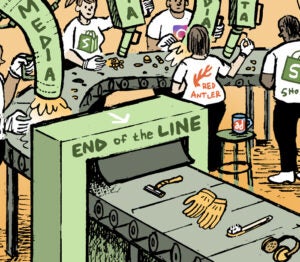“Data-Driven Thinking” is written by members of the media community and contains fresh ideas on the digital revolution in media.
Today’s column is written by Alison Levin, VP of global marketing solutions at Roku.
Black Friday has traditionally been the kick-off of the holiday season for the retail industry, but this year, like many other things in 2020, normal is no longer normal. As a result of the pandemic, three-quarters of consumers report they will not be setting foot inside a physical store on Black Friday this year, according to a Harris Poll survey. At the same time, that survey found that 40% of consumers plan to shop online for Black Friday deals and that nearly two-thirds of Americans will be well underway with their holiday shopping before Thanksgiving.
This is not necessarily bad news for marketers who are prepared to adapt to the “normal of now.” Despite all of the COVID-19 impacts, Deloitte predicts that holiday shopping will actually increase this year, topping $1 trillion in sales between November and January.
The evolving shopping patterns that are shifting when and where and how consumers make purchases has created an expanded playing field for brand marketers. What used to be three separate moments over the course of late November/early December – Black Friday, Small Business Saturday and Cyber Monday – will now be combined and expanded over the course of the entire month of November and into December.
The Home Depot kicked off its Black Friday specials on Nov. 6, Walmart announced early deals on Nov. 11 and Best Buy launched its “Treat Yourself” early shopper savings program the first week in November, all designed to capture the billions of dollars that consumers plan to spend on themselves and others this year. All of these retail trends speak to a larger retail narrative now unfolding: Consumers are shopping earlier and they are becoming far more sophisticated with how they research items and ultimately make purchasing decisions.
And there are multiple indicators pointing to the permanency of many of the once considered “temporary” fixes retailers deployed to adapt to the COVID-19 retail environment. For example, one recent survey found that 87% of consumers want brands to continue to offer curbside pickup and other processes that limit the need for in-person visits even after COVID-19 subsides.
For marketers who embrace these emerging trends, the benefits are clear. According to The New York Times, Target reported curbside sales grew more than 700% in the last quarter and Best Buy reported nearly $5 billion in online revenue in the second quarter of 2020 with four out of every 10 dollars spent coming from curbside or in-store pickup.
These retail behavior shifts are just one of the changing trends reshaping the marketing landscape. While news of the large increases in time spent streaming have widely been reported, what has not been so widely picked up is the fact that much of this time has not been additive to overall TV viewing. The number of holiday shoppers that are now totally unreachable to brands through traditional linear television campaigns has exploded with more than 3 million households shedding their cable subscriptions in the first half of 2020 alone.
Now marketers are not only needing to adjust their overall holiday promotional programs to encompass a 10-week timeframe (versus a handful of specific days), but also shift their marketing budgets to where consumers are actually spending the majority of their content viewing time.
These shifts are also fueling another trend impacting marketing strategies this holiday – the need for fresh creative. With an elongated holiday shopping and advertising season, we are beginning to see multiple brands develop two and even three complete rounds of holiday-focused creative campaigns to ensure their messages remain fresh and relevant. Brands are engaging shoppers earlier with messaging designed, for example, for the “self-purchaser” who will shop for themselves first this year before shifting to others on their gift-giving list later in the season.
Another trend taking shape against this backdrop is one of urgency and flexibility. Many brands are concerned about a repeat from the spring, where COVID-19 dramatically impacted inventory availability. This possible scenario is why many brands are promoting their products early and heavily, well ahead of the traditional Thanksgiving weekend. It is also shaping marketer budget decisions as more dollars flow into flexible platforms such as streaming that can turn on a dime to focus spend in geographies with inventory or to specific products not impacted by shipping constraints. With this flexibility comes the option to deploy small targeted campaigns to niche audiences as well as large scale takeover campaigns designed to reach every streaming household.
AdExchanger Daily
Get our editors’ roundup delivered to your inbox every weekday.
Daily Roundup
What only just one year ago we would have deemed to be the normal holiday strategy playbook to attract and retain consumers is no more. Consumers have shifted how, when and where they want to shop. Linear television has ceded its position as the dominant vehicle to reach most shoppers at a time when marketers face a new holiday calendar that is both longer, but also fuller, with rich opportunities to engage shoppers that plan to spend more this season. Brands must now embrace this opportunity to try new approaches and win the loyalty of consumers this holiday season and beyond.
Follow Roku (@Roku) and AdExchanger (@adexchanger) on Twitter.













